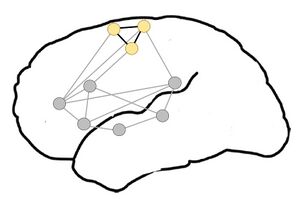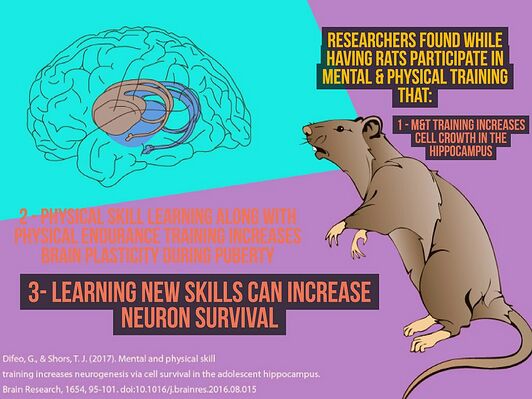Neuroplasticity After Stroke: Difference between revisions
No edit summary |
No edit summary |
||
| Line 9: | Line 9: | ||
[[File:Neural Network.jpeg|thumb|Neuroplasticity: rewiring neurons]] | [[File:Neural Network.jpeg|thumb|Neuroplasticity: rewiring neurons]] | ||
Following a [[stroke]], the healthy areas of the [[Brain Anatomy|brain]] around the damaged brain tissue region are able to compensate and develop new functions. [[Neuroplasticity]] is the term that describes this rewiring and reorganising process. This process includes: inter-hemispheric lateralisation, association [[Cerebral Cortex|cortical]] regions making new connections in the injured area, and re-organisation of cortical representational maps. Brain plasticity leads to a great degree of spontaneous recovery, and stroke rehabilitation plays an important role in modifying and boosting this neuronal plasticity process.<ref>Hara Y. [https://www.jstage.jst.go.jp/article/jnms/82/1/82_4/_article Brain plasticity and rehabilitation in stroke patients.] Journal of Nippon Medical School. 2015 Feb 15;82(1):4-13. Available: https://www.jstage.jst.go.jp/article/jnms/82/1/82_4/_article<nowiki/>(accessed 1.1.2023)</ref> | Following a [[stroke]], the healthy areas of the [[Brain Anatomy|brain]] around the damaged brain tissue region are able to compensate and develop new functions. [[Neuroplasticity]] is the term that describes this rewiring and reorganising process. This process includes: inter-hemispheric lateralisation, association [[Cerebral Cortex|cortical]] regions making new connections in the injured area, and re-organisation of cortical representational maps. Brain plasticity leads to a great degree of spontaneous recovery, and stroke rehabilitation plays an important role in modifying and boosting this neuronal plasticity process.<ref>Hara Y. [https://www.jstage.jst.go.jp/article/jnms/82/1/82_4/_article Brain plasticity and rehabilitation in stroke patients.] Journal of Nippon Medical School. 2015 Feb 15;82(1):4-13. Available: https://www.jstage.jst.go.jp/article/jnms/82/1/82_4/_article<nowiki/>(accessed 1.1.2023)</ref> | ||
Table 1 - Key neuroplastic changes associated with stroke rehabilitation | |||
{| class="wikitable" | {| class="wikitable" | ||
! colspan="1" rowspan="1" |Neuroplastic changes | ! colspan="1" rowspan="1" |Neuroplastic changes | ||
! colspan="1" rowspan="1" |Description of changes | ! colspan="1" rowspan="1" |Description of changes | ||
! colspan="1" rowspan="1" |Neural structures involved | ! colspan="1" rowspan="1" |Neural structures involved | ||
|- | |- | ||
| | | colspan="1" rowspan="1" |Dendritic remodelling | ||
| colspan="1" rowspan="1" |Structural changes in dendrites, including sprouting and arborisation | |||
| colspan="1" rowspan="1" |Affected and unaffected brain regions | |||
|- | |||
| colspan="1" rowspan="1" |Synaptic plasticity | |||
| colspan="1" rowspan="1" |Strengthening or weakening of synapses based on activity and experience | |||
| colspan="1" rowspan="1" |Neurotransmitter systems, cortical and subcortical regions | |||
|- | |- | ||
| | | colspan="1" rowspan="1" |Cortical reorganisation | ||
| colspan="1" rowspan="1" |Changes in cortical maps and functional organisation of brain regions | |||
| colspan="1" rowspan="1" | | | colspan="1" rowspan="1" |Motor and sensory cortices, association areas | ||
| | |||
| | |||
|- | |- | ||
| | | colspan="1" rowspan="1" |Neurogenesis | ||
| | | colspan="1" rowspan="1" |Generation of new neurons in specific brain regions | ||
| | | colspan="1" rowspan="1" |Hippocampus, subventricular zone | ||
| | |||
|- | |- | ||
| | | colspan="1" rowspan="1" |Axonal sprouting | ||
| | | colspan="1" rowspan="1" |Formation of new connections or sprouting of existing axons | ||
| | | colspan="1" rowspan="1" |Corticospinal tract, other neural pathways | ||
| | |||
|} | |} | ||
== Physical Activity And Neuroplasticity == | == Physical Activity And Neuroplasticity == | ||
[[Physical Activity|Physical activity]] (PA) can promote neural plasticity. | [[Physical Activity|Physical activity]] (PA) can promote neural plasticity. | ||
Revision as of 22:51, 19 November 2023
This article or area is currently under construction and may only be partially complete. Please come back soon to see the finished work! (19/11/2023)
Original Editor - Lucinda Hampton
Top Contributors - Lucinda hampton, Rahma Ahmed Ahmed Bahbah, Candace Goh and Tolulope Adeniji
Introduction[edit | edit source]
Following a stroke, the healthy areas of the brain around the damaged brain tissue region are able to compensate and develop new functions. Neuroplasticity is the term that describes this rewiring and reorganising process. This process includes: inter-hemispheric lateralisation, association cortical regions making new connections in the injured area, and re-organisation of cortical representational maps. Brain plasticity leads to a great degree of spontaneous recovery, and stroke rehabilitation plays an important role in modifying and boosting this neuronal plasticity process.[1] Table 1 - Key neuroplastic changes associated with stroke rehabilitation
| Neuroplastic changes | Description of changes | Neural structures involved |
|---|---|---|
| Dendritic remodelling | Structural changes in dendrites, including sprouting and arborisation | Affected and unaffected brain regions |
| Synaptic plasticity | Strengthening or weakening of synapses based on activity and experience | Neurotransmitter systems, cortical and subcortical regions |
| Cortical reorganisation | Changes in cortical maps and functional organisation of brain regions | Motor and sensory cortices, association areas |
| Neurogenesis | Generation of new neurons in specific brain regions | Hippocampus, subventricular zone |
| Axonal sprouting | Formation of new connections or sprouting of existing axons | Corticospinal tract, other neural pathways |
Physical Activity And Neuroplasticity[edit | edit source]
Physical activity (PA) can promote neural plasticity.
- PA effects in the peri-infarct site (post stroke): promotes cerebral angiogenesis, vasomotor reactivity, neurotrophic factor release; reduces apoptosis processes, excitotoxicity, and inflammation.
- PA provides neuroprotective effects capable of reducing adverse effects of brain ischemia, with pre-stroke physical fitness decreasing the severity of motor deficits.[2]
- Stroke therapy combining physical training with pharmacological treatments, is known to promote neuroplasticity. [2]
- Brain-derived neurotrophic factor (BDNF) is a key facilitator of neuroplasticity. Evidence suggests that aerobic exercise is an important intervention for improving brain function, these effects are mediated partly by upregulation of BDNF. As such aerobic exercise–induced increases in BDNF help facilitate motor learning-related neuroplasticity for rehabilitation after stroke.[3][4]
Physiotherapy[edit | edit source]
Utilising the brains' ability to create and lay down new pathways, the physiotherapist can play a big role in rehabilitation and improved quality of life. Physical therapy can positively promote neuroplasticity during stroke rehabilitation, approaches include:
- Constraint induced movement therapy (CIMT) for the arm and hand
- Task-oriented therapy and repetition of novel movements
- Gait training
- Aerobic exercises
- Dual-task training, involving Motor Dual-Task Training and Cognitive Dual-Task Training
- Vitual Reality
- Mental Imagery
- Action Observation Therapy
- Electrical Stimulation
- Mirror Therapy
See also Stroke: The Evidence for Physiotherapy
References[edit | edit source]
- ↑ Hara Y. Brain plasticity and rehabilitation in stroke patients. Journal of Nippon Medical School. 2015 Feb 15;82(1):4-13. Available: https://www.jstage.jst.go.jp/article/jnms/82/1/82_4/_article(accessed 1.1.2023)
- ↑ 2.0 2.1 Pin-Barre C, Laurin J. Physical exercise as a diagnostic, rehabilitation, and preventive tool: influence on neuroplasticity and motor recovery after stroke. Neural plasticity. 2015 Oct;2015. Available:https://www.hindawi.com/journals/np/2015/608581/?utm_source=bing&utm_medium=cpc&utm_campaign=HDW_MRKT_GBL_SUB_BNGA_PAI_DYNA_JOUR_X_X0000_WileyFlipsBatch2&utm_term=Acta%20Neurologica%20Scandinavica&utm_content=JOUR_X_X0000_WileyFlipsBatch2_ActaNeurologicaScandinavica (accessed 1.1.2023)
- ↑ Mang CS, Campbell KL, Ross CJ, Boyd LA. Promoting neuroplasticity for motor rehabilitation after stroke: considering the effects of aerobic exercise and genetic variation on brain-derived neurotrophic factor. Physical therapy. 2013 Dec 1;93(12):1707-16.Available:https://www.ncbi.nlm.nih.gov/pmc/articles/PMC3870490/ (accessed 1.1.2023)
- ↑ Penna LG, Pinheiro JP, Ramalho SH, Ribeiro CF. Effects of aerobic physical exercise on neuroplasticity after stroke: systematic review. Arquivos de Neuro-Psiquiatria. 2021 Oct 18;79:832-43.








